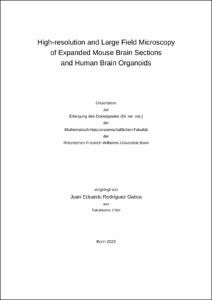High-resolution and Large Field Microscopy of Expanded Mouse Brain Sections and Human Brain Organoids

High-resolution and Large Field Microscopy of Expanded Mouse Brain Sections and Human Brain Organoids

| dc.contributor.advisor | Kubitscheck, Ulrich | |
| dc.contributor.author | Rodriguez Gatica, Juan Eduardo | |
| dc.date.accessioned | 2024-04-08T07:53:37Z | |
| dc.date.available | 2024-04-08T07:53:37Z | |
| dc.date.issued | 08.04.2024 | |
| dc.identifier.uri | https://hdl.handle.net/20.500.11811/11480 | |
| dc.description.abstract | Connectome analysis, the comprehensive mapping of neural connections within an organism nervous system has long been a formidable challenge in neuroscience. Traditional methods often fall short in providing a holistic view of neural circuits, especially when attempting to balance high-resolution imaging with the need to cover large tissue volumes. This study addresses this challenge by introducing a transformative imaging technique, Light Sheet Fluorescence Expansion Microscopy (LSFEM). LSFEM synergizes two powerful imaging modalities: light sheet fluorescence microscopy (LSFM) and expansion microscopy (ExM). Conventionally, while confocal microscopy excels in capturing high-resolution images of tissue sections and small model organisms, it struggles with larger samples. On the other hand, tomographic techniques, suitable for centimeter-sized samples often compromise on resolution. LSFEM effectively bridges this divide enabling cellular resolution imaging of millimeter-sized samples, thus providing a solution that is both expansive in coverage and meticulous in detail. Drawing inspiration from the design blueprint proposed by Baumgart & Kubitscheck, a custom-built light sheet microscope was developed. This microscope, characterized by its upright design, underwent iterative refinements with a focus on enhancing both axial and lateral resolution. A standout feature of the final design is its objective revolver that allows for swift magnification changes during a single acquisition session. This adaptability combined with the microscope's ability to accommodate diverse sample sizes aligns seamlessly with the "Smart imaging" concept, which optimizes imaging performance by selectively targeting specific portions of a vast volume. The application of LSFEM was demonstrated in the mapping of neural circuits within the mouse hippocampus and cortex. This approach provided unprecedented insights into the organizational principles of these circuits, capturing intricate subcellular structures like dendritic spines and synaptic junctions. Historically, such detailed imaging necessitated the use of high-resolution microscopy techniques, such as electron microscopy or super-resolution optical microscopy. However, these methods often come with their own set of challenges, including intensive sample preparation, potential introduction of artifacts or limitations in sample volume coverage. LSFEM's transformative approach offers a solution that is both efficient and versatile. By physically expanding the sample, the effective resolution is enhanced, allowing for the capture of intricate subcellular structures. This technique supports large analysis volumes, a stark contrast to the limited range of methods like STED. Furthermore, LSFEM is compatible with a plethora of staining and labeling techniques, enabling selective identification of specific cell types or structures. Beyond its applications in neuroscience, the potential of LSFEM extends to fields like developmental biology and cancer research. The study also introduces a new iteration along with lattice light-sheet microscopy (LLSM) using innovative hardware for lattice light-sheet generation tailored for expanded samples, further enhancing the imaging capabilities. With the burgeoning development of artificial intelligence (AI) tools in image analysis, the synergy of AI methods with LSFEM presents a potent combination to tackle the connectome problem. In conclusion, LSFEM offers a groundbreaking approach to super-resolution imaging, promising efficient and detailed imaging studies in the future. By leveraging this technique, researchers can achieve a comprehensive understanding of tissue architecture and organization, propelling advancements in connectomics research and beyond. | en |
| dc.language.iso | eng | |
| dc.rights | Namensnennung 4.0 International | |
| dc.rights.uri | http://creativecommons.org/licenses/by/4.0/ | |
| dc.subject | connectomics | |
| dc.subject | mouse brain | |
| dc.subject | organoids | |
| dc.subject | light sheet microscopy | |
| dc.subject | expansion microscopy | |
| dc.subject | super resolution | |
| dc.subject.ddc | 540 Chemie | |
| dc.title | High-resolution and Large Field Microscopy of Expanded Mouse Brain Sections and Human Brain Organoids | |
| dc.type | Dissertation oder Habilitation | |
| dc.identifier.doi | https://doi.org/10.48565/bonndoc-259 | |
| dc.publisher.name | Universitäts- und Landesbibliothek Bonn | |
| dc.publisher.location | Bonn | |
| dc.rights.accessRights | openAccess | |
| dc.identifier.urn | https://nbn-resolving.org/urn:nbn:de:hbz:5-75353 | |
| dc.relation.doi | https://doi.org/10.1117/1.NPh.6.1.015005 | |
| dc.relation.doi | https://doi.org/10.1364/OE.393728 | |
| dc.relation.doi | https://doi.org/10.1242/dev.200439 | |
| ulbbn.pubtype | Erstveröffentlichung | |
| ulbbnediss.affiliation.name | Rheinische Friedrich-Wilhelms-Universität Bonn | |
| ulbbnediss.affiliation.location | Bonn | |
| ulbbnediss.thesis.level | Dissertation | |
| ulbbnediss.dissID | 7535 | |
| ulbbnediss.date.accepted | 22.02.2024 | |
| ulbbnediss.institute | Mathematisch-Naturwissenschaftliche Fakultät : Fachgruppe Chemie / Institut für Physikalische und Theoretische Chemie | |
| ulbbnediss.fakultaet | Mathematisch-Naturwissenschaftliche Fakultät | |
| dc.contributor.coReferee | Merkel, Rudolf | |
| ulbbnediss.contributor.orcid | https://orcid.org/0000-0003-4123-0104 |
Files in this item
This item appears in the following Collection(s)
-
E-Dissertationen (4395)




